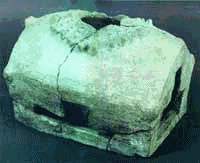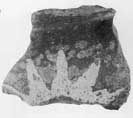With a relatively well spread network of road communications
it was possible of unhindered links between the proto Macedonian tribes,
and their incorporation in the system of the so called "Neolithic revolution",
because of that, today we have more proof of organised inhabitation since
the early stone age (early Neolithic) and with indications of an
older period, which means that Macedonia has evidence of an evolution
of her own culture, of a long continued period of implementing links with
other civilisation areas in the Balkan and even wider regions (map
3). Example: The Neolithic material of east Macedonia Vrshnik at Tarintsi
(close to Shtip) shows a narrow connection with some occurrences in Trakiya
(Karanovo) as well as with the early so called cultural groups in Anadolia.
A Neolithic culture of the Skopje region shows certain similarities with
that of the so called Starchevo group and Vincha group, while
the older phase of the art and the literacy on the cliffs of Tsrna
Loma (Black Ruin) or Ilina Gora (Solar Forest) at Osinchani close to Skopje
corresponds with the Lepenski Vir Culture .
 
 Neolithic
inhabitation of the so called Porodin group on Pelagonija show a specific
sign on living and burial. The archaeological material found in the many
tombs near the Black river (map 4) show an exceptional
knowledge of organising space, and semantic shaping of the
Neolithic pots which are a clear testimony of the respect for the
cult of the sun and the cult of the cosmos, (space, universe)
and a longer cultural continuity with the oldest (up to now) registered
solar symbols and diverse cosmographies, cosmogonies and cosmologies
from around 5.500 B.C.. Neolithic
inhabitation of the so called Porodin group on Pelagonija show a specific
sign on living and burial. The archaeological material found in the many
tombs near the Black river (map 4) show an exceptional
knowledge of organising space, and semantic shaping of the
Neolithic pots which are a clear testimony of the respect for the
cult of the sun and the cult of the cosmos, (space, universe)
and a longer cultural continuity with the oldest (up to now) registered
solar symbols and diverse cosmographies, cosmogonies and cosmologies
from around 5.500 B.C..
Similar symbols are discovered in the localities in Skochivir canyon
and in the Kratovo region, the Skopje region abundans of cosmography, cosmonomy
, astrology and solar symbols in the area of Tsrna
Loma or Ilina Gora near the village Osinchani (picture 3), dated at
about 7.000 - 6.000 B.C. in the place "Tserje" at Govrlevo at the age of
6.000 B.C.[Picture 5]
[Picture 6]
The Macedonian Neolithic revolution and evolution , as well as
the one from the Balkan - along the Danube and Balkan - Anadolia (map5)
spaces is not cut of as some modern archaeologists would claim, but instead
it has transformed and evolved to a higher degree of development of the
material and spiritual culture. Possible migrations of some populations
from East to West, from North to South and back could not be the cause
or reason for the complete demise of cultures and populations of the Balkans.
The established road communications enabled awareness among people of all
the innovations and discoveries, they enabled trade and economic links
among members of different tribes and later nations, they also enabled
invasions of members of one tribe on other tribes, of one people on others
but all of this could not contribute to a drastic or catastrophic radicalisation
of the situation and a total wiping off the prehistoric and historic scene
of all the tribes or the peoples in other words the whole population on
the Balkan peninsular north of the Thermopiles. To this type of a conclusion
we come from our palaeographic and paleolinguist research because in Macedonia,
Serbia, Romania, and wider there is a conformation to the continual
presence of the so-called pre Slav population which used an alphabet and
language which today could be identified as ancient Macedonian through
different stages of development of its material culture on the Balkan peninsular.
Beside the shown constatations it should be emphasised that common
elements of the material culture of the so called pre Slav population
from the so named different cultural groups from the separate territories
on the Balkan actually just confirme the closenes or relatedness of the
ethnic members to their so called cultural groups from the end of the Mesolithic
and the beginning of the Neolithic right up till today on the Balkan
mild comfortable space for living and surviving that
are situated between the geographic lattitude of 20 degrees and 45
degrees northern lattitude, i.e. between the parallel that forms a belt
where the oldest civilation centres in the world are found(map
3). The often registered migration of certain inhabited suburbs
and places from one location to another as well as the appearance in the
stratography of the cultural layers from different inhabitants of all kinds
of artefacts made out of different material, colour, symbols, quality
etc. is not relevant to the so claimed total disappearance of a suburb,
culture or population, but on the contrary it could be a testimony to the
existence of cycles of evolution and evolutionary transformations
in the cultural continuity of a separate suburb, cultural group, population.
|
 DISCOVERIES
ABOUT THE LITERACY, LANGUAGE
DISCOVERIES
ABOUT THE LITERACY, LANGUAGE DISCOVERIES
ABOUT THE LITERACY, LANGUAGE
DISCOVERIES
ABOUT THE LITERACY, LANGUAGE
